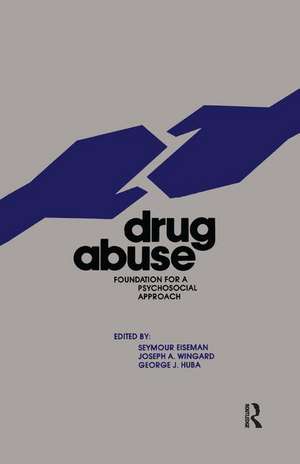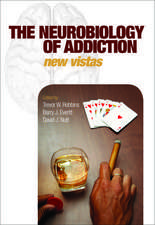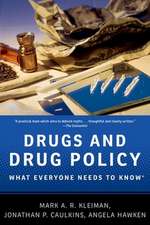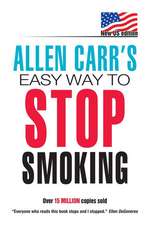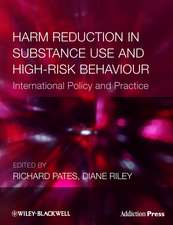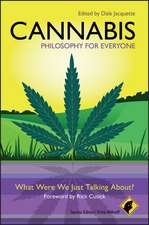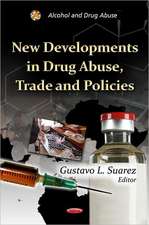Drug Abuse: Foundation for a Psychosocial Approach
Autor Seymour Eiseman, Joseph Wingard, George Hubaen Limba Engleză Hardback – 7 mai 2019
| Toate formatele și edițiile | Preț | Express |
|---|---|---|
| Paperback (1) | 713.56 lei 6-8 săpt. | |
| Taylor & Francis – 15 iun 1984 | 713.56 lei 6-8 săpt. | |
| Hardback (1) | 1287.77 lei 6-8 săpt. | |
| Taylor & Francis – 7 mai 2019 | 1287.77 lei 6-8 săpt. |
Preț: 1287.77 lei
Preț vechi: 1355.55 lei
-5% Nou
Puncte Express: 1932
Preț estimativ în valută:
246.41€ • 257.97$ • 203.89£
246.41€ • 257.97$ • 203.89£
Carte tipărită la comandă
Livrare economică 07-21 aprilie
Preluare comenzi: 021 569.72.76
Specificații
ISBN-13: 9780415785853
ISBN-10: 0415785855
Pagini: 268
Dimensiuni: 152 x 229 x 16 mm
Greutate: 0.52 kg
Ediția:1
Editura: Taylor & Francis
Colecția Routledge
Locul publicării:Oxford, United Kingdom
ISBN-10: 0415785855
Pagini: 268
Dimensiuni: 152 x 229 x 16 mm
Greutate: 0.52 kg
Ediția:1
Editura: Taylor & Francis
Colecția Routledge
Locul publicării:Oxford, United Kingdom
Public țintă
Professional Practice & DevelopmentCuprins
Foreword
Preface
PART I THEORY
Applications of a Theory of Drug Use to Prevention Programs George J. Huba, Joseph A. Wingard, and Peter M. Bentler
Constructive Peer Relationships, Social Development, and Cooperative Learning Experiences: Implications for the Prevention of Drug Abuse David W. Johnson
An Approach to Primary Prevention of Drug Abuse Among Children and Youth—Parental Influence Seymour Eiseman
Education about Narcotics and Dangerous Drugs—A Challenge to Our Schools Seymour Eiseman
Which Way Drug Education? Stephen F. Wepner
Drug Education—A Turn On or A Turn Off? Michael S. Goodstadt
A Critique of Values: Clarification in Drug Education Chwee Lye Chng
Substance Abuse Prevention Programming and Research: A Partnership in Need of Improvement Richard Dembo
PART II RESEARCH
Adolescent Drug Use and Intentions to Use Drugs in the Future: A Concurrent Analysis George J. Huba, Joseph A. Wingard, and Peter M. Bentler
Alcohol Use and Self-Esteem of Adolescents Wayne R. Mitic
Multivariate Prediction of Cigarette Smoking Among Children in Grades Six, Seven and Eight Linda L. Pederson, Jon C. Baskerville, and Neville M. Lefcoe
Awareness of Substance Abuse and Other Health-Related Behaviors Among Preschool Children Forest S. Tennant, Jr.
Patterns of Drug Use Among Mexican-American Potential School Dropouts James E. Bruno and Lynn Doscher
The Relationship Between Self-Reported Religiosity and Drug Use by College Students Carol J. Turner and Robert J. Willis
Empirically-Derived Hierarchy of Use for Psychotropics: A Cost Benefit Index Khalil A. Khavari and Frazier M. Douglass
PART III PRACTICE
Sources of Information About "Drugs" Margaret A. Sheppard
Trends in Use of Alcohol and Other Substances on Television
Bradley S. Greenberg, Carlos Fernandez-Collado, David Graef, Felipe Korzenny, and Charles K.
Atkin
Smoking, Drugging and Drinking in Top Rated TV Series Bradley S. Greenberg
Films and Drug Education Margaret A. Sheppard and Michael S. Goodstadt
Opinions of Seventh to Twelfth Graders Regarding the Effectiveness of Pro- and Anti-Smoking Messages Samuel W. Monismith, Robert E. Shute, Richard W. St.Pierre, and Wesley F. Alles
A Cross-Cultural Field Study of Drug Rehabilitation Methodologies in Sweden and the United States Robert D. Mann and Joseph Wingard
Use of Gestalt Therapy Within a Drug Treatment Program Stephen I. Sideroff
Issues in the Training of Alcoholism Counselors Andris Skuja
Drug Program Evaluation: Outcome Measures John W. Murphy
Cont
Preface
PART I THEORY
Applications of a Theory of Drug Use to Prevention Programs George J. Huba, Joseph A. Wingard, and Peter M. Bentler
Constructive Peer Relationships, Social Development, and Cooperative Learning Experiences: Implications for the Prevention of Drug Abuse David W. Johnson
An Approach to Primary Prevention of Drug Abuse Among Children and Youth—Parental Influence Seymour Eiseman
Education about Narcotics and Dangerous Drugs—A Challenge to Our Schools Seymour Eiseman
Which Way Drug Education? Stephen F. Wepner
Drug Education—A Turn On or A Turn Off? Michael S. Goodstadt
A Critique of Values: Clarification in Drug Education Chwee Lye Chng
Substance Abuse Prevention Programming and Research: A Partnership in Need of Improvement Richard Dembo
PART II RESEARCH
Adolescent Drug Use and Intentions to Use Drugs in the Future: A Concurrent Analysis George J. Huba, Joseph A. Wingard, and Peter M. Bentler
Alcohol Use and Self-Esteem of Adolescents Wayne R. Mitic
Multivariate Prediction of Cigarette Smoking Among Children in Grades Six, Seven and Eight Linda L. Pederson, Jon C. Baskerville, and Neville M. Lefcoe
Awareness of Substance Abuse and Other Health-Related Behaviors Among Preschool Children Forest S. Tennant, Jr.
Patterns of Drug Use Among Mexican-American Potential School Dropouts James E. Bruno and Lynn Doscher
The Relationship Between Self-Reported Religiosity and Drug Use by College Students Carol J. Turner and Robert J. Willis
Empirically-Derived Hierarchy of Use for Psychotropics: A Cost Benefit Index Khalil A. Khavari and Frazier M. Douglass
PART III PRACTICE
Sources of Information About "Drugs" Margaret A. Sheppard
Trends in Use of Alcohol and Other Substances on Television
Bradley S. Greenberg, Carlos Fernandez-Collado, David Graef, Felipe Korzenny, and Charles K.
Atkin
Smoking, Drugging and Drinking in Top Rated TV Series Bradley S. Greenberg
Films and Drug Education Margaret A. Sheppard and Michael S. Goodstadt
Opinions of Seventh to Twelfth Graders Regarding the Effectiveness of Pro- and Anti-Smoking Messages Samuel W. Monismith, Robert E. Shute, Richard W. St.Pierre, and Wesley F. Alles
A Cross-Cultural Field Study of Drug Rehabilitation Methodologies in Sweden and the United States Robert D. Mann and Joseph Wingard
Use of Gestalt Therapy Within a Drug Treatment Program Stephen I. Sideroff
Issues in the Training of Alcoholism Counselors Andris Skuja
Drug Program Evaluation: Outcome Measures John W. Murphy
Cont
Notă biografică
Seymour Eiseman, Joseph Wingard, George Huba
Descriere
Presents findings and theoretical models within a psychosocial framework, which draws upon understanding the physiological, psychological, interpersonal, and social forces that are the causes of youthful drug addiction.
